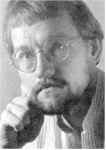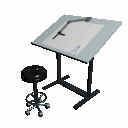|
|
|
|
||||||||||||||||||||||
|
||||||||||||||||||||||
|
Bemærk: Dette websted opdateres
ikke. |
||||||||||||||||||||||
| INGO MILTON |
|
| Ingo Milton Larsen blev født i 1954.
Allerede i 1972 fik han publiceret sin og broderen Freddys krimistrip Zenit i dagbladet Jyllands-
Posten. I 1977 forlod han kunsthåndværkerskolen i Kolding og arbejdede herefter på reklamebureu. I 1980 var han med til at danne tegnesetuefællesskabet Gimle i København, og 1983-86 arbejdede han med lay out på Valhalla-tegnefilmen. I 1987 deltog han uden at vinde i dagbladet Ekstrabladet's tegneseriekonkurrence, men konkurrencebidraget Skyggen - efter H.C.Andersens historie - blev samme år bragt som føljeton i det konkurrerende dagblad B.T. I 1993 udkom denne personlige og flot gennemarbejdede tegneserie i et albumformat, som fremhævede den afbalancerede sort/hvide grafik og de stemningsfulde miljø- og interiørskildringer. I samme stil begyndte Ingo Milton i 1989 at udvikle sin tegneserie fra 1400-tallets Danmark, Narrenes hat. Projektet, som i mellemtiden har skiftet titel til Mester Lucifer, blev tilendebragt i 1996, hvor det udkom i albumformat farvelagt af Lasse Holm. Siden midten af 80erne har Ingo Milton via reklamebureauet Advance haft tilknytning til Lego. Denne tilknytning er bl.a. resulteret i små instruktive tegneserier, som beskriver anvendelsen af Lego's legetøj i de årlige kataloger. Desuden har han i en årrække farvelagt albumforsider for forlagene Interpresse og Carlsen. Fra 2002 har Ingo Milton sammen med Jan Kjær leveret tegneserien Alfa, Sepp & Stick til det danske manga-hæfte Kurt Dunder & Kompagni. |
| Ingo Milton was born
in 1954. In 1972 his detective strip Zenit, done in
collaboration with his brother Freddy, was
published in the daily newspaper JyllandsPosten. In 1977 he graduated
from the School of Arts and Crafts in Kolding and began work at an advertising agency. In 1980 he helped found the Gimle studio cooperative in Copenhagen, and from 1983-86 he worked on layouts for the Valhalla animated featurefilrn. He has also colored album covers for the publishers interpresse and Carlsen for many years. In 1987 he entered the newspaper Ekstrabladet's comics competition with Skyggen (The Shadow) , based on a tale by Hans Christian Andersen. The story belongs to Andersen's more sinister tales. It describes a writer, who gradually loses his body to the dark side of his personality. Milton's comic did not win the competition, but was serialized that same year by the competing newspaper, B.T. In 1993 this carefully prepared comic appeared in album format, bringing out the contrasting black and white style and the atmospheric settings. Today Ingo Milton works on his own album senses Skalken Joff (Joff the Scamp) . This comic is set in 1400's Denmark. The three main characters, Joff, Elena, and Sashia are traveling mountebanks, touring the countryside while performing with their puppet-theatre at town fairs. The first 48 page episode was published by Carlsen in 1996 as an album entitled Mester Lucifer (Master Lucifer). In this story the three friends unsuspectingly drive their carriage into the heavily fortified city of Kalundborg. Here, they realise that their coarse, crowd-pleasing performance is not appreciated by everyone at the castle. Soon they find themselves involved in a court-intrigue that tests their friendship to the limit. The album is skillfully co1ored by Lasse Holm. The second episode, Grådbroderens Hånd (The Grey Friar's Hand) , brings the three puppeteers to medieval Copenhagen, where they get entangled in the mysterious disappearance of a holy relic. Asked why he has chosen to develop his tales in a historic setting, Milton answers: "There are several reasons. I am fascinated by the fashions and decor of the past. I simply find it more fun to draw a table of wodden planks, than a post-modernistic glasspane on a chrome frame. Also, society seemed simpler then, (at least seen from today's point of view). Therefore, it's easier to tell a story with clear-cut characters and conflicts in a historic setting than in a contemporary one. Today you sue your opponents and wait two years for a decision. That's not the kind of drama suitable for comics. They need stories with visual elements too, to justify the format. It was easier in the old days: First you called each other names, and then you drew the sword..." |



